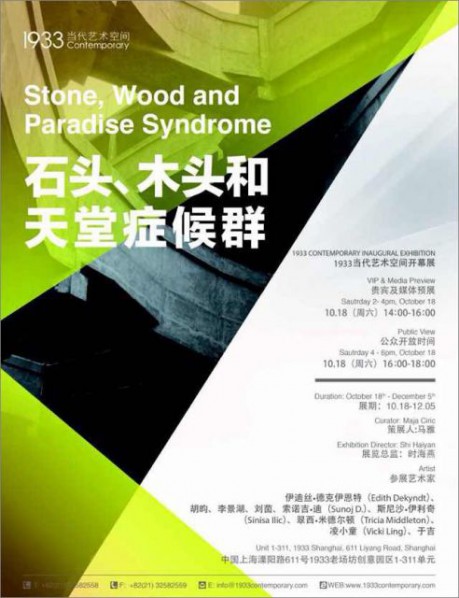
If the purpose of an exhibition is to create knowledge that is greater than the sum of its parts, the title of the inaugural exhibition at 1933 Contemporary, does not reveal only its inner formal, conceptual and geo-political structure, but gallery's overall and long term intensions.
What is it to curate if not to make a selection of artistic positions and to find the line that connects them all that resonates in a specific context?
Looking from the inside, the space is formally and conceptually divided in three parts, each part corresponding to one of the aspects in the title: Stone, Wood and Paradise Syndrome. In terms of materials of the artworks, they (in)directly evoke stone and wood, as elements of inner structure of the historical building in which the exhibition is taking place, while the Paradise Syndrome refers to the historical legacy of the building. The materials are connecting the exhibited artworks with a local context and its sensibility visually, but simultaneously they connect different cultural positions. The formal here, reveals the conceptual. Fundamentally organized around dominant universal materials such as wood and stone, this exhibition seems open to different influences, yet it shows an exclusive selection. Three parts of the title, have a second layer of meaning, they resonate with universality.
If curating implies taking care of an exhibition, this project is an opportunity to present choices grounded in the independent thought. The choices of artists and artworks are not only market driven, but predominantly driven by caring for the positioning of both the artist and the artworks. When it comes to artists, this exhibition is trans-generational and trans-national, while in terms of artworks this exhibition showcases the artworks that have not yet been exhibited in Shanghai. Geo-politically, the exhibition abandons the international aspect, in which the artists would solely be exposed as an extension of the national art world, and reinforces the trans-national aspect of the art world that relates to the gallery vision to represent, both emerging and established global players of the art world. Articulated as a trans-generational and trans-national, this exhibition transcends the existing positioning in the art world.
To walk from the room entitled Stone to the room entitled Paradise Syndrome implies going a distance. On a metaphorical level, it takes a distance to articulate the cannons of contemporary curating in a way that they resonate properly in a local context. It takes a distance to make an exhibition that showcases new aspects of some Chinese artists, as well as it takes a distance to present renowned, but not predictable selection of foreign artists. It takes the distance to make unpredictable, yet valuable choices.
In order to create an exhibition that is larger than a sum of its parts, this exhibition opens new chapter in what referring to exhibition making in the commercial realm in China today can imply. The title refers to how reconfigured positions are negotiated and investigate the roles that artists and curators perform in the gallery framework they inhabit.
Artists drew disparate works together through notions of site-specificity while their positions are resonating with universal questions. The gallery vision is that way articulated through formal approach.
About the exhibition
Duration: Oct 18, 2014 - Dec 5, 2014
Opening: Oct 18, 2014, 14:00, Saturday
Venue: 1933 Contemporary Art
Curator: Ćirić Maja
Artists: Sunoj D, Edith Dekyndt, Hu Yun, Sinisa Ilic, Li Jinghu, Ling Vicki, Liu Yin, Tricia Middleton, Yu Ji
Courtesy of the artists and 1933 Contemporary Art, for further information please visit http://1933contemporary.com.




























